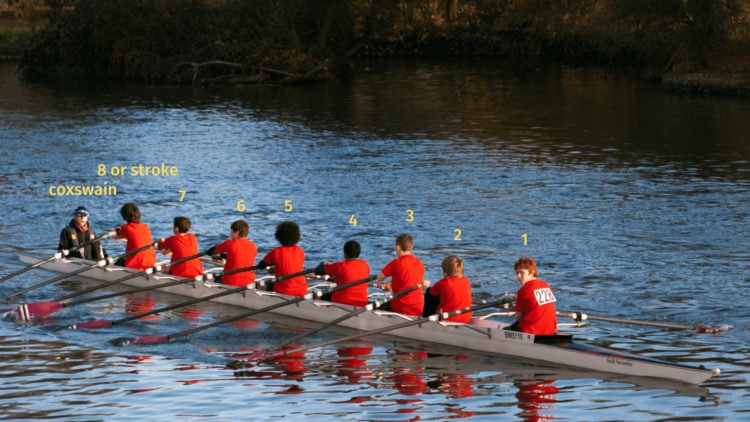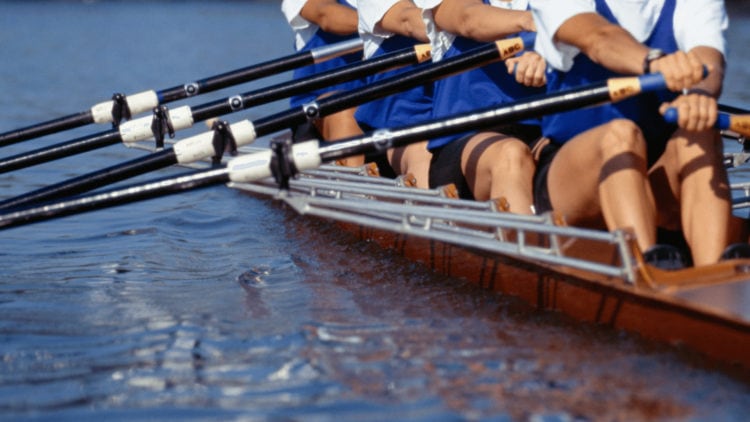
OBJECTIVE OF ROWING: Row faster to reach the finish line before all other competitors.
NUMBER OF PLAYERS: one to eight rowers per boat
MATERIALS: Boat, two oars per rower
TYPE OF GAME: Sport
AUDIENCE: 12+
OVERVIEW OF ROWING
Rowing is a competitive water sport that sees athletes race each other in oar-powered boats. Although every rowing event is fundamentally similar, the manpower allotted to each team can drastically vary, with some events calling for one athlete per boat while others call for as many as eight!
Rowing began as a basic means of aquatic transportation, likely dating back thousands of years to the ancient Egyptian civilization. Due to its utility, oar-based water transport survived the test of time, becoming especially prevalent in the naval activities of the Danish and Norwegian Vikings during medieval times.
The racing of water vessels likely came to fruition in England in the 1500s when passengers in transport ships started betting on which ships would make it to their destination first. These disorganized races soon turned organized, with “Doggett’s Coat and Badge”, the first ever professional boat race, being held in 1715. This race has been held annually in Britain for the past 300 years, with local ferrymen still competing to this very day.
The first official governed sport was rowing. The governing body was founded and named the National Association for Amateur Oarsmen in 1872, this was later changed in 1982 to the United States Rowing Association which it remains today.
SETUP
EQUIPMENT
Racing Shells: This is the term used to refer to the various boats used in competitive rowing competitions. This name comes from the fact that rowing boats are often hollow and extremely thin. Most organizations do not have weight specifications for these boats, although most are constructed of composite material to reduce the shell’s total weight. There are two types of boats most commonly used sculling boats, which have a single line of rowers with two oars each. Then there is also sweep boats which have rowers facing one side with one oar each. To accommodate the different team sizes, each shell has different dimensions based on the event:
- Single : 27 feet in length; 30+ lbs in weight
- Pair: 34 feet in length; 60+ lbs in weight
- Four: 44 feet in length; 115+ lbs in weight
- Eight: 62 feet in length; 212+ lbs in weight
Oars: Similar to the racing shells, oar material, and weight are not often specified. However, modern day oars are usually made of carbon fiber to optimize their strength while minimizing their weight. There are two types of oars used for competition:
- Scull Oars: These oars measure roughly 8 to 10 feet in length. Competitors use two of these at once—one in each hand.
- Sweep Oars: These are the longest oars, measuring between 11 and 13 feet in length. These are often used in the eight-person events, as an athlete only uses one of these at a time (and therefore only rows on one side of the boat). This is known as sweep rowing.
POSITIONS

Rowers (or scullers) are given a number based on where in the boat they sit. The “number 1” is the athlete who sits at the boat’s bow, or the part of the shell that crosses over the finish line first. Each subsequent athlete is ranked 2 through 8, depending on how close to the bow they sit.
Rowers 1 and 2 are called the bow pair while rowers 7 and 8 are known as the stern pair.
Athlete 8, who sits farthest from the bow, is known as the “stroke”. This athlete is often the strongest, most technically sound team member, as they must set the rowing pace that the entire group must follow.
The coxswain, who is only present in certain events (mostly sweep oar races), acts as the mid-race coach responsible for controlling the boat’s rudder. Races that do not include a coxswain are known as “coxless” events.
EVENTS
Rowing event names are determined by the number of athletes per boat and which oars are used.
- Scull: These can include teams of singles, pairs, and quads. As the name suggests, the rowers use scull oars (one in each hand).
- Coxed/Coxless: These events are frequently performed by teams of two or four with sweep oars. “Coxed” refers to the boat having a coxswain on board, while “coxless” refers to the absence of a coxswain.
- Eights: The largest rowing event, eights include eight sweep-oar rowers and one coxswain. Coxswains are necessary for this event, as the speeds at which these boats travel can be dangerous without one present.
GAMEPLAY

THE RACE
Every rowing event begins with each boat centered in front of its own miniature dock. Upon the sound of the starting gun, the athletes start rowing down the course. In rowing races, as with most other racing sports, a team is allowed a single false start before they are disqualified upon their second infraction.
Like a 100-meter track event, each boat has its own lane to start in. These lanes are completely straight, with the event’s focus being pure speed. Interestingly, teams are allowed to cross into other lanes as long as they do not impede another boat’s progress.
Regardless of team size, all rowing events take place on a 6,560-foot still-water course. The team whose bow first crosses the finish line is deemed the winner, with each subsequent team ranked in the order they finish.
There are also head races in the fall. In a head race the rowers start at different time intervals and can be of varying length.
ROWING TECHNIQUE
The rowing motion and rowing stroke are designed to be as efficient as possible. To accomplish this, athletes face away from the direction they’re moving, allowing them to leverage their back muscles to propel their boat.
Similar to the cardio-based seated rowing machine (ergometer) that can be found in most gyms, the seats on which the athletes sit slide along a track. This moving seat allows them to use their legs in addition to their upper body when pulling the oar blade.
THE REIGNING WORLD RECORD
Due to the vast variability in water and weather conditions, there are no “world records” but rather “world bests”. The current fastest 2000m time of 5 minutes and 18 seconds (05:18:68) was set by an eight-man German team in 2017 at the Rowing World Cup held in Poland.
German Eight World’s Best Time (5:18.68)
As may be expected, boats with more manpower, despite being heavier, can move much faster than smaller teams. Additionally, warm water conditions and tailwinds can provide the ideal world-best conditions for rowers.
In the 2005 World Rowing Championships held in Japan, multiple world-best times were recorded at this single event. It was decided that these times would not be considered official records since the competitors were racing on water that held a fast current from the recent typhoon. Environmental variabilities such as these are precisely why “world best” times aren’t as coveted as in other race-based sports.
END OF GAME
The team whose boat crosses the finish line before all other competitors is deemed the victor of the rowing race.
- 30 GAMES TO PLAY OVER TEXT - April 22, 2024
- 20+ FREE PRINTABLE BABY SHOWER GAMES - April 16, 2024
- 20+ College Party Games for the Best Night Ever! - April 2, 2024